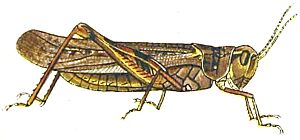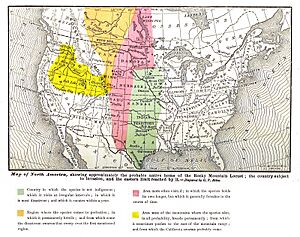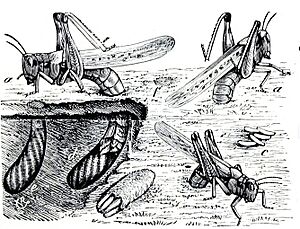Rocky Mountain locust facts for kids
Quick facts for kids Rocky Mountain locust |
|
|---|---|
 |
|
| 1902 illustration | |
| Conservation status | |
| Scientific classification | |
| Genus: |
Melanoplus
|
| Species: |
spretus
|
 |
|
| Synonyms | |
|
|
The Rocky Mountain locust (Melanoplus spretus) was a type of grasshopper that is now extinct. These insects used to live across the western United States and parts of Canada. They were known for forming incredibly huge swarms.
One famous swarm in 1875 was thought to cover an area bigger than California. It weighed about 27.5 million tons and had an estimated 12.5 trillion insects! This was possibly the largest group of animals ever seen.
But less than 30 years later, this amazing species was gone. The last time anyone saw a live one was in 1902 in southern Canada. Because they were so common, not many specimens were saved. However, some preserved remains have been found in glaciers in Wyoming and Montana.
The Rocky Mountain locust was a food source for the Eskimo curlew, a bird that is also now very rare or possibly extinct. Some scientists think the loss of the locusts might have contributed to the decline of the curlew.
Contents
What is the Rocky Mountain Locust?
The scientific name for the Rocky Mountain locust is Melanoplus spretus. It was first named Caloptenus spretus in 1866 by B.D. Walsh. The name "spretus" means "despised." This might have been because scientists had overlooked it before.
Later, in 1878, scientists decided to place it in the genus Melanoplus. This was because of differences between the two groups of insects.
Where Did They Live?
The Rocky Mountain locust lived on both sides of the Rocky Mountains. They also lived in most of the prairie areas. They liked sandy places and did well in hot, dry weather.
Some scientists believe they might have needed tall prairie grasses during dry times. Changes to their habitat, like farming and new plants, may have led to their extinction. Many grasshoppers, including these locusts, got trapped in the ice of the Rocky Mountains. This is why a place there is called the Grasshopper Glacier.
Why Did They Disappear?
Rocky Mountain locusts caused damage to farms as early as the 1700s. But they became a much bigger problem in the 1800s. This was when farming spread west into the areas where the locusts lived. There were many outbreaks between 1828 and 1874.
The Great Swarms of the 1870s
The last huge swarms happened between 1873 and 1877. These swarms caused about $200 million in crop damage. This happened in states like Colorado, Kansas, and Nebraska.
One farmer said the locusts looked "like a great, white glistening cloud." Another described it as "a big snowstorm." The locusts ate everything. They ate grass, crops, leather, wood, and even clothes! Trains sometimes stopped because their wheels slipped on the many locusts on the tracks.
Farmers tried many ways to stop them. They used gunpowder and fires. They also used "hopperdozers," which were plows that knocked locusts into pans of poison. Some even tried vacuum-like machines. But nothing worked against such huge numbers.
Farmers Fight Back
A scientist named Charles Valentine Riley even suggested eating the locusts. He had a recipe for them fried in butter. But most people preferred to starve than eat the insects!
Farmers finally took strong action. In 1877, a law in Nebraska said people had to work to kill locusts. Missouri offered money for collected locusts. Other states did similar things.
In the 1880s, farmers recovered. They also started growing different crops, like winter wheat. This wheat ripened early, before the locusts migrated. These new farming methods helped reduce the locust threat. They also played a big part in the species' downfall.
The Mystery of Their Extinction
Scientists believe that farming practices destroyed the locusts' eggs. Plowing, irrigation, and farm animals walking near rivers in the Rocky Mountains likely crushed the eggs. Farmers reported killing over 150 egg cases per square inch by plowing or flooding.
It seems the locusts only lived and reproduced on the prairie temporarily during swarm years. Their main breeding grounds were small areas of sandy soil near rivers in the Rockies. These areas were also where settlers farmed.
For a while, some thought the Rocky Mountain locust might not be truly extinct. They wondered if a regular grasshopper could turn into a locust under the right conditions. But experiments did not show this. In 2004, DNA tests confirmed that M. spretus was a unique species.
The IUCN officially declared the Rocky Mountain locust extinct in 2014.
In Culture
Some chapels were built in Minnesota after the locust plagues. For example, Assumption Chapel in Cold Spring was built in 1877. Farmers hoped it would protect them from future locust problems. A day called "Grasshopper Day" was even celebrated.
Another chapel, St. Boniface in St. Augusta, was built for the same reason. People still make pilgrimages there.
The famous children's book On the Banks of Plum Creek by Laura Ingalls Wilder talks about the locusts. It describes how they destroyed her family's wheat crop in the 1870s. This was based on real events.
Another book, Giants in the Earth by Ole Edvart Rølvaag, also shows the locusts' destruction.
In 2018, an opera about the Rocky Mountain locust called Locust: The Opera was performed. It was based on a book by Jeffrey Lockwood.
See also
- Locust Plague of 1874
- List of recently extinct insects
- Mormon cricket – another large, swarming insect from western North America
- Passenger pigeon – another example of a North American species that became extinct quickly due to human activities






